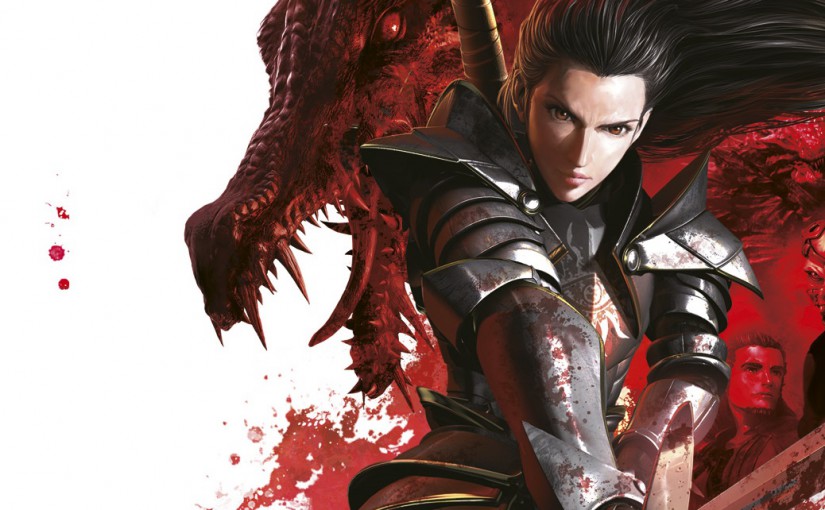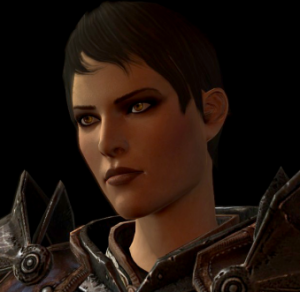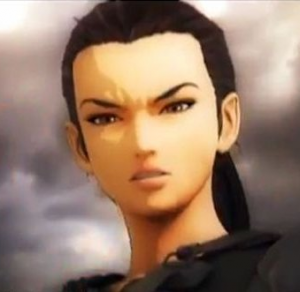“Dawn of the Seeker” is a Japanese CG-anime film set in Bioware’s Dragon Age universe. It takes place after the events of Dragon Age 2, and follows the adventures of the Templar Seeker, Cassandra Pentaghast (who we had the pleasure of meeting for the first time in Dragon Age 2), and her Mage sidekick, Galyan, as they strive to thwart a conspiracy against the Chantry.
In a nutshell: Dragon Age is a high-magic setting, but magic is kept under strict supervision by the Chantry (a monotheistic, Christian-like religious institution), and their military wing, the Templars. People with an inborn ability to wield magic – the Mages – are routinely taken away from their families as children, to be brought up and educated inside the Circles of Magi, where their potential susceptibility to turn very, very bad, is kept in check. They can never leave, and at best, live a life of limited freedom: they cannot go where they please, do what they will, marry and have children. If they attempt to break away from these rules, they are declared to be apostates, and the Templars either hunt down and kill them, or make them ‘tranquil’ in a ritual that boils down to spiritual castration. In other words, Mages are an oppressed minority.
They are also a dangerous minority. Magic in Dragon Age comes from the dream-realm called the Fade, which is inhabited by spirits and demons. Mages draw their power from the Fade, but are constantly exposed to the influence of these beings, who always seek to seduce a Mage into landing them their body so that they can experience the physical world. If the Mage gives in, they become possessed, an abomination, and through the pact with the demon who inhabits them, they gain terrible power. This is how the Chantry explains the need to keep all Mages isolated and controlled.
The themes of oppression and abuse of power, of corruptibility and religious indoctrination, are explored in many situations in Dragon Age games, books and now, movies. So far, perhaps most notably in DA 2, the writers have been making every effort to keep this conflict – between the Mages and the Chantry, between the undebatable weakness of an individual and their right to be free – in the shady realm well away from black and white. And while the situation has been greatly simplified for the viewers of DotS, it remains deep enough in the gray, and stands as a worthy member of the saga.
With some caveats, of course.
First off, the plot is painfully formulaic. I knew exactly how it would end before it hit the first quarter. It’s also painfully similar to the plot of Angels and Demons. But I could detect nothing especially stupid, so I suppose it’s ‘ok’, if not really satisfying.
Cassandra looks like Lara Croft and she’s similarly invincible. Her prowess with sword and shield was set up early in the show and was used in moderation against people; but on a couple of occasions it was way, way over the top. First, when she outright assaulted a fucking army of ogres and stone golems on her own; and later, when she singlehandedly executed four dragons and a monstrous abomination. For a viewer who hasn’t played the games, this is probably a shrug-worthy enumeration. But I found it insulting on the part of the heroic characters I spent dozens of hours with. Namely, anyone who played Dragon Age: Origins will remember that poor King Cailan was slain by an ogre, and that the Warden’s entire party had to employ every trick in their repertoire to bring another down in the Tower of Ishal. Not to mention the untimely death of one of Hawke’s siblings in the beginning of Dragon Age 2, also by the hands of an ogre. Sure, in both games they become somewhat more manageable over time, but the people who grow to take them down with ease are legends. Is Cassandra a legend? It’s sorta difficult to accept that. And what of dragons? The ‘value’ of dragons has been rolling down a steady slope since DA:O, where it took three Gray Wardens to take down one dragon (albeit, the Archdemon), and the Wardens – not the Seekers – should be the ultimate badasses of the setting.
(Yeah, I’m starting to sound like those people who yell at each other on various forums, arguing about which character is stronger. I’ll stop now.)
The other thing that bothered me about Cassandra, is that in DotS she doesn’t seem to be the grown-up, confident, self-sufficient tough chick we got to see in DA 2. There must have been some years between DA 2 and DotS, because she obviously had the time to grow a pony-tail.
So what’s this with fencing lessons and a father-figure, and, come to think of it, the title? It just doesn’t fit. The only thing in the movie that managed to surprise me was the reference to Kirkwall, establishing the place DotS has in the timeline – I was convinced it was something from Cassandra’s past, something that would explain the role of the ultimate arbiter she plays in DA 2. In DotS, she’s devolved into an insecure, explosive, ‘angsty’ girl for who this adventure is a rite of passing. It’s all wrong.
I approve of the reversal of traditional gender roles in the relationship between the aggressive, manly Cassandra and the gentle, shy Galyan, even if it is a bit hackneyed. What I don’t approve of (although I’ll admit that I might have missed it if not for a warning from a friend who has a better eye for these things), is that all the Blood (read, bad) Mages wear skirts, and all the Circle (read, good) Mages, wear slacks. Oh, well.
Even though I’m not a fan of anime, I found the art agreeable. The visuals weren’t bad, so as to annoy me, nor were they outrageous, so as to distract me. Many elements of interior design and architecture, monsters, armor and weapons, reminded me of the games; it was a pleasure to see them come to life, so to speak. Action sequences also had a familiar vibe, and I think I heard fleeting traces of my favorite pieces from game soundtracks here and there. I have no objections to these aspects.
In fact, the only serious objections I do have, go back to the simplifications I mentioned before. The Templar must always be corrupted; the Mage must always turn into a monstrous abomination; the main character must always be declared hero/champion of the land in the end, and there must always be attraction between opposites. It’s not only the plot: everything is formulaic.
Now, as I recently said in defense of my heretical acceptance of Mass Effect 3 and all its supposed flaws, I seem to be a very forgiving fan. I’ve been away from the Dragon Age community for far too long to be able to calibrate my impressions against the opinions held by the fandom, but I imagine the hardcore fans, and especially lore enthusiasts, can’t be very happy. For me, DotS is harmless entertainment, and it’s good for what it is.


